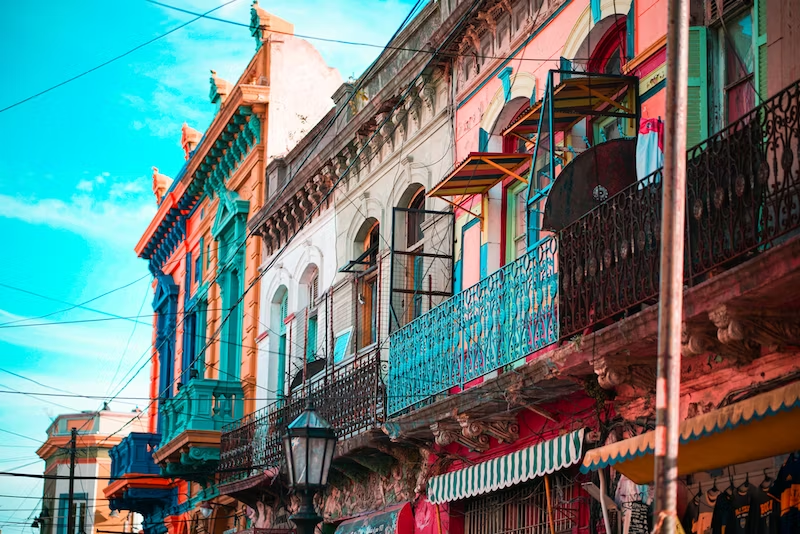The 10 Best Things to Do in Buenos Aires According to Reddit

Are you planning a trip to the vibrant heart of Latin America and wondering what to do when visiting Buenos Aires? Look no further! This guide, curated with suggestions from Reddit's well-traveled community, is your ultimate resource for exploring Buenos Aires.
Immerse yourself in the authentic Argentine experience, from wandering the historic streets of San Telmo to absorbing the lively ambiance of La Boca. Sign up to receive occasional deal communications to enhance your journey.
Don't miss the tranquility of Parque Tres de Febrero, a lush haven in the bustling city. To taste Buenos Aires, dive into the San Telmo Market, a local culture and cuisine treasure trove. Embark on your Buenos Aires adventure and discover amazing Buenos aires activities
Before diving into the bustling streets of Buenos Aires, let's talk about practicality. You wouldn't want to lug your bags around while exploring, right? Here's where Nannybag's luggage storage Buenos Aires service comes to the rescue!
Conveniently located, Nannybag allows you to safely store your luggage and enjoy your day in the city unburdened and carefree. Now, with your hands-free and mind at ease, let's discover what Buenos Aires offers!
1. Plaza de Mayo: The Heart of Buenos Aires
Plaza de Mayo is not just the geographical heart of Buenos Aires but also its historical and political soul. This iconic square has been the focal point of many of Argentina's most pivotal moments, including revolutions and major public demonstrations. Its importance is underscored by significant buildings like the Casa Rosada, the presidential palace with its distinctive pink hue and Italianate style.
The plaza is also bordered by other key structures, such as the Metropolitan Cathedral and the Cabildo, offering a rich tapestry of architectural styles. On a sunny day, the plaza's historical charm is complemented by a vibrant atmosphere, with street performers, local artisans, and the buzz of city life. This dynamic environment, combined with the square's historical significance, makes it a must-visit for anyone seeking to understand the spirit of Buenos Aires.
2. Stroll Along Puerto Madero
Puerto Madero is a shining example of successful urban regeneration. This former port area, once neglected and rundown has been transformed into one of Buenos Aires' most upscale neighborhoods. The rejuvenation has preserved the old red-brick warehouses, now repurposed into elegant restaurants, chic bars, and luxurious offices, juxtaposed with cutting-edge modern towers that symbolize the city's forward-thinking attitude.
Strolling along the dockside, visitors have a serene waterfront experience, starkly contrasting to the bustling city center. The Puente de la Mujer, a striking pedestrian bridge designed by Santiago Calatrava, is a highlight and becomes a spectacular sight when illuminated at night. The area's transformation from a rundown port to a sophisticated, modern district makes Puerto Madero a symbol of Buenos Aires' resilience and adaptability, reflecting the city's blend of tradition and innovation.
3. Casa Rosada: A Pink Presidential Palace
Casa Rosada, the presidential palace of Argentina, is an architectural and cultural beacon in Buenos Aires. Its distinct pink color is a unique aesthetic choice and a symbol of Argentina's political history, blending the traditional red and white colors of the country's two dominant political parties. The palace's architecture, a blend of Italianate and neoclassical styles, showcases the country's European influences.
Casa Rosada holds a special place in the nation's collective memory, notably the balcony from which Eva Perón famously addressed the masses, a moment that has become an integral part of Argentina's political folklore. Inside, the palace houses a museum that presents rich artifacts, providing visitors with a deeper understanding of Argentina's complex and layered history. Casa Rosada is more than a government building; it symbolizes Argentine resilience, history, and culture.

4. Tango and Antiques at Plaza Dorrego
Plaza Dorrego, located in the heart of the San Telmo district, is a vibrant epicenter of culture and history. Known for its Sunday market, the plaza transforms into a bustling hub of activity where locals and tourists converge to experience the essence of Buenos Aires. The area is synonymous with tango, Argentina's famous dance. Visitors can witness spontaneous tango performances in the open air, offering a glimpse into the passionate and artistic soul of the city.
The surrounding antique shops are treasure troves of history, each item telling a story of Buenos Aires' past. The plaza is lined with quaint cafés and bars, perfect for enjoying a leisurely coffee or traditional Argentine wine while absorbing the lively atmosphere. Plaza Dorrego encapsulates the spirit of Buenos Aires, blending history, art, and daily life into a tapestry that is as captivating as it is dynamic.
5. The Colorful Streets of La Boca
La Boca is a vibrant emblem of Buenos Aires' cultural and artistic identity. This neighborhood is particularly celebrated for its multicolored house hues that brighten the streets and create a lively, joyful atmosphere. The history of these colors traces back to the local shipyard workers who used leftover marine paint to cover their homes, resulting in the rainbow of shades seen today.
Caminito Street, the heart of La Boca, is a particular highlight. This pedestrian walkway is flanked by brightly painted metal houses, many of which are now converted into art galleries and souvenir shops. The street is like a living canvas, reflecting the neighborhood's immigrant roots and bohemian spirit.
Art is a central feature of La Boca, with local artists regularly showcasing their work along Caminito and nearby streets. These artworks often depict scenes of everyday life in Buenos Aires, tango dancers, and other cultural symbols, offering a glimpse into the city's soul.
Tango is synonymous with La Boca. The neighborhood is often considered the birthplace of this passionate dance, and its spirit is palpable in the air. Street performers captivate onlookers with their elegant, fiery tango moves, contributing to the neighborhood's vibrant atmosphere.
Despite its charm, La Boca is a neighborhood of contrasts, and visitors are advised to stay within the well-traveled areas, particularly during the day, for the best and safest experience.
6. Experience a Guided Tour of the Opera Houses
Buenos Aires' opera houses are not just venues for performances; they are monuments to the city's rich cultural history, with the Teatro Colón as a standout example. Considered one of the finest opera houses in the world, Teatro Colón boasts an architectural grandeur that matches its global reputation.
The opera house opened in 1908 and is a masterpiece of acoustics and architectural design. Its lavish interior is adorned with marble, gold leaf, and European stained glass, creating an ambiance of elegance and history. The main auditorium is a spectacle of opulence, with a magnificent chandelier and intricate frescoes.
A guided tour of Teatro Colón or other opera houses in the city offers a behind-the-scenes glimpse into the world of Argentine performing arts. These tours showcase the stunning architecture and decor and delve into the history and stories that have shaped these cultural landmarks. They provide insight into the elaborate stagecraft and the intricate workings of opera and ballet productions.
Booking a tour in advance is advisable, as these experiences are highly popular among locals and tourists. Visiting one of Buenos Aires' opera houses is more than just a tour; it's a journey through the heart of Argentina's artistic and cultural heritage.
7. Palacio Barolo: A Literary Landmark
Palacio Barolo is an architectural wonder and a tribute to literature, specifically Dante Alighieri's "Divine Comedy." Its design is rich with symbolic references to the epic poem, with the structure representing the journey from hell to paradise.
The building's unique style blends Gothic, Romanesque, and Art Nouveau elements, making it a fascinating subject for architecture enthusiasts. A visit to Palacio Barolo is incomplete without ascending to the rooftop, where you are rewarded with breathtaking panoramic views of Buenos Aires. This building is more than just a visual spectacle; it's a journey through literary and architectural imagination.
8. The Metropolitan Cathedral: An Architectural Gem
The Metropolitan Cathedral in Buenos Aires is not just a place of worship but an architectural masterpiece. This cathedral stands out for its eclectic blend of styles, featuring neoclassical and baroque elements. Its façade, resembling a Greek temple with towering columns, invites visitors into a world of historical and spiritual significance. Inside, the cathedral houses the mausoleum of General José de San Martín, a revered figure in Argentine history.
The interior is equally impressive, adorned with intricate artwork, sculptures, and religious iconography that reflects the rich religious heritage of Argentina. Exploring the cathedral's interior is a must-do, as it reveals the elaborate art and décor that make this place a revered landmark in Buenos Aires.
9. Café Tortoni: More Than Just Coffee
Café Tortoni, established in 1858, is much more than a café; it's a historical landmark and a cultural icon in Buenos Aires. This café exudes a timeless charm, with its Art Nouveau décor, stained glass ceilings, and classic wooden furniture. Its walls are adorned with memorabilia and pictures of famous visitors, offering a glimpse into the café's storied past.
As a gathering place for artists, writers, and intellectuals, Café Tortoni has played a significant role in Argentine cultural life. It has been a venue for poetry readings, jazz concerts, and literary gatherings, making it a hub of artistic and intellectual discourse.
The café's menu pays homage to traditional Argentine flavors, with its famous churros de Buenos Aires and dulce de leche, a delightful combination that visitors must try. The atmosphere here is nostalgic, providing a serene escape from the bustling city outside.
Café Tortoni offers a unique experience that transcends the usual café visit. It's an opportunity to immerse oneself in the rich tapestry of Argentine culture and history, making it a must-visit destination in Buenos Aires.

10. Football Fever: Boca Juniors and Beyond
Football in Buenos Aires is a phenomenon that captures the heart and soul of the city. The Boca Juniors, one of Argentina's most successful football teams, is central to this passion. Their home ground, La Bombonera, is more than a stadium; it's a temple of football where emotions run high.
The atmosphere at a Boca Juniors match is electric, with fans singing and cheering throughout the game. The supporters' passion, known as 'La Doce' or 'The 12th Player', is contagious, making the experience exhilarating for even casual observers.
For those unable to catch a live match, stadium tours offer a fascinating insight into the club's history and culture. These tours allow visitors to explore the locker rooms, the players' tunnel, and the stands, providing a sense of the stadium's intense atmosphere on match days.
Football in Buenos Aires is a reflection of the city's vibrant spirit. Whether experiencing the feverish atmosphere at La Bombonera or exploring the rich history of Argentine football through a stadium tour, visitors are sure to be captivated by the sport's significance in Buenos Aires.

Say hello to exploring and goodbye to heavy bags!
What if you could enjoy every minute in the city without the burden of your bags?
- Safe luggage storage for a flat daily price of ٤٬٠٠٠٫٠٠ ARS/luggage item
- Included luggage protection of up to €10000 in case of breakage, loss or theft
